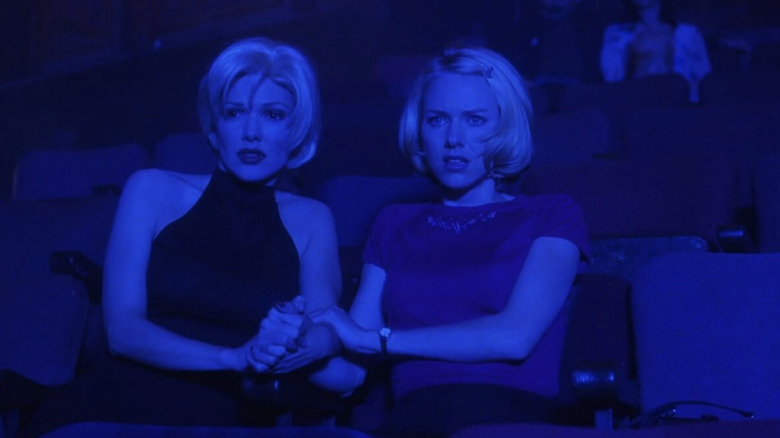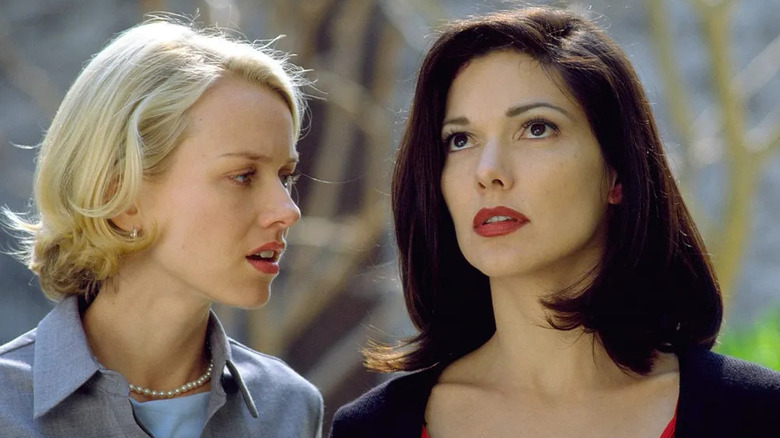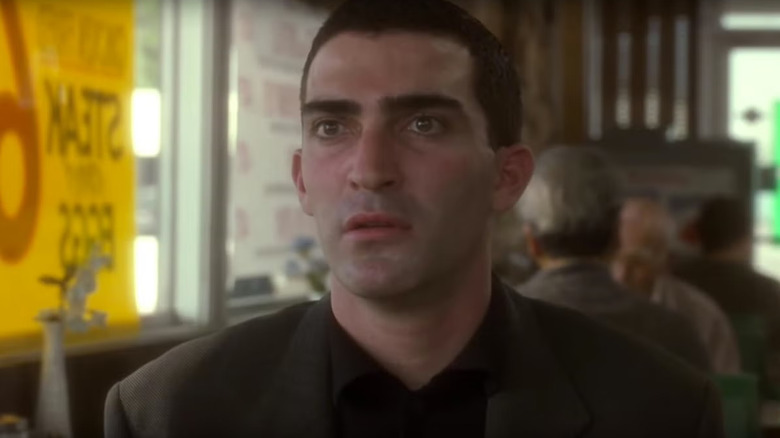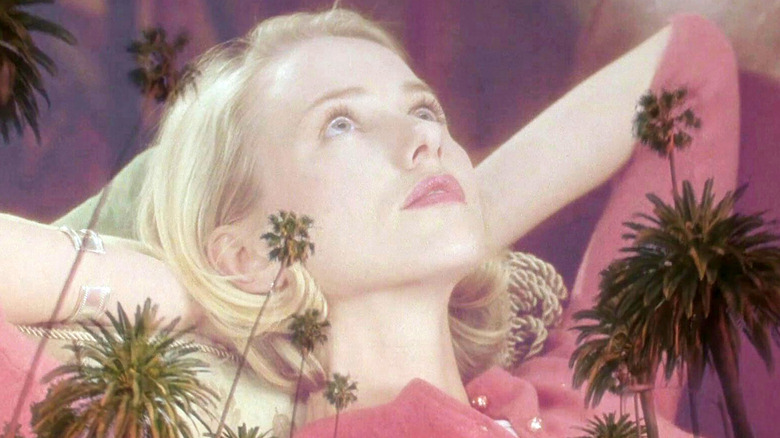The One Time David Lynch Gave Us Clues To Unlock His Work
If there's one thing that David Lynch's passing on January 16th, 2025 revealed, it's that the filmmaker and artist had a profound and massive impact on so many people. This is, on paper, surprising, given how esoteric and offbeat his work was throughout his career, not to mention how unapologetic he was about that fact. A consummate artist, Lynch confounded and delighted so many in equal measure because he was that rarest of creatures: a quintessentially American surrealist. Americans are somewhat used to European filmmakers employing surrealism or symbolism; at least, they can easily dismiss foreign directors as coming from a culture and tradition they don't know and don't understand. Lynch doesn't allow people the comfort of that response, as even a cursory look at his filmography reveals it to be steeped in pure Americana: the wind blowing through Douglas Firs, the smell of fresh, hot, black coffee and cherry pie coming from a small town diner, and so on. These images, these elements, are so recognizable to Americans, and yet Lynch reveled in shifting their meaning ever so slightly, finding the menace and ominous, repressed secrets lurking behind every Hollywood facade and white picket fence.
One of the most popular memes surrounding Lynch comes from an interview he gave with David Lean at BAFTA, during which he described "Eraserhead" as his "most spiritual film." When Lean asked Lynch to elaborate, Lynch flatly refused. This meme succinctly sums up Lynch's usual approach to discussing his work, let alone decoding it, with the filmmaker resolute about letting audiences interpret his films their own way. While this isn't a new or uncommon path for a director to take — Brady Corbet is currently avoiding all sorts of interpretation questions on his press tour for "The Brutalist," for instance — Lynch's ethos is notable for both how wildly interpretive his work is and how steadfast he was over the course of his career about never budging on that front.
Never, that is, save a few rare occasions. The more one digs into the supplementary materials Lynch approved to be released officially, the more one can find (slightly) larger hints as to his mysterious process and ways of creative thinking. Material such as his books (especially "Room to Dream") and behind-the-scenes footage (especially those released on the "Inland Empire" and "Twin Peaks: The Return" home media) cracks the mystery of Lynch open a bit. Arguably the biggest key to decoding Lynch, however, came via a flyer he personally wrote to be included with the "Mulholland Dr." DVD, a document which, whether on the level or not, is a great starting point when it comes to unlocking his work.
Why Lynch chose Mulholland Dr. as a place to begin decoding
Of course, the initial questions when confronted with this document are why Lynch would choose to suddenly give out clues to decoding one of his films, and why "Mulholland Dr." in particular. After all, this clip currently making the rounds from the 74th Academy Awards, in which Roger Ebert spots Lynch in the press line and asks him a point-blank question about how many characters Naomi Watts plays in "Mulholland Dr.," sees Lynch refuse to answer Ebert's query with a "How ya doin', Roger?" And then there's this other clip, in which Lynch eloquently sums up his love of cinema as an art form and why he believes numerous, individual interpretations of his films are far more valuable than his own.
An easy answer to why Lynch would write the flyer included with the "Mulholland Dr." DVD (entitled "Mulholland Drive: David Lynch's 10 Clues to Unlocking This Thriller") is that Lynch's career was at a bit of a low point when "Mulholland Dr." was being made. The film originally began life as a TV pilot for Touchstone Television and ABC, with Lynch looking to return to the small screen after his success with "Twin Peaks." After the phenomenon around that series died down, Lynch experienced several financial and critical failures, with now-beloved films "Twin Peaks: Fire Walk With Me" and "Lost Highway" flailing, a sitcom called "On the Air" barely making it to air, and even his well-received movie which proved he could branch out into all-ages fare, "The Straight Story," failing to make its budget back at the box office.
After "Mulholland Dr." was rejected by ABC, Lynch made a Hail Mary pass and decided to write and shoot additional material to make the pilot into its own closed-ended (of a sort, anyway) feature. Fortunately, the feature version of "Mulholland Dr." received acclaim when it premiered at Cannes in 2001, and the good buzz around it continued enough that it made a profit when it was released by Universal Pictures later that year. Thus, Lynch may have understandably been twice shy about his work and its reception, which could've led to that DVD flyer and its clues.
However, Lynch seemed to exert a large degree of creative control over the release of "Mulholland Dr.," going so far as to have instructions for its projection sent to all the theaters playing the film and insisting that the DVD release have no chapter stops on the disc, meaning that the movie had to be watched in one continuous sitting. In this way, the clues document isn't Lynch acquiescing to public demand but rather is one more part of the puzzle of the film and his work that he explicitly intended.
David Lynch's clues to unlocking his work
For those of you who haven't read the "Mulholland Dr." clues document, you may be thinking that these clues are fairly straightforward hints as to the larger meaning of the film's layered narrative. Not so fast, as you can see:
- "Pay particular attention in the beginning of the film: At least two clues are revealed before the credits.
- Notice appearances of the red lampshade.
- Can you hear the title of the film that Adam Kesher is auditioning actresses for? Is it mentioned again?
- An accident is a terrible event—notice the location of the accident.
- Who gives a key, and why?
- Notice the robe, the ashtray, the coffee cup.
- What is felt, realized, and gathered at the Club Silencio?
- Did talent alone help Camilla?
- Note the occurrences surrounding the man behind Winkie's.
- Where is Aunt Ruth?"
These clues are presented in Lynch's inimitable style; they're simultaneously utterly simple and bafflingly beguiling. They're also very straight-laced, the questions phrased like a public school quiz might be. The clues feel less like a Cliff's Notes guide to the film and more like an extension of it, as phrases like "Notice appearances of the red lampshade" feel akin to the Cowboy (Monty Montgomery) telling Adam (Justin Theroux) what will happen if he does "good" or "bad." There's an undeniable tension between the images, dialogue, and scenes Lynch presents and their elusive meanings, as even the biggest Lynch hater can feel that there is a logic and intention at work in Lynch's films. These things all mean something, in other words, and aren't just arbitrary weirdness for weirdness' sake.
Many debates were held on message boards and other online forums regarding these clues and their actual answers, with many folks becoming frustrated because — big surprise here — they had differing opinions of what the answers were, and what they all added up to. The early '00s were a sort of golden age of filmmakers utilizing their ability to discuss and package their films on physical media as a way of enhancing and extending the film's impact; witness Christopher Nolan recording multiple endings to his commentary track for "Memento," ensuring that no two casual listeners will walk away with the same "definitive" explanation for that movie's events. These clues are Lynch's version of that idea for "Mulholland Dr." — further questions disguised as answers.
Lynch insists on giving us room to dream
Ultimately, the clues document was a huge gift to fans of David Lynch and his work. It just wasn't the gift it necessarily purported to be, because while those clues may or may not unlock "Mulholland Dr.," they certainly invite further thought and questioning on the audience's part, which is the entire point. Yes, some such people believe ambiguity is some kind of flaw or at least a source of frustration. Yet, at the risk of demeaning them, these people simply fail to understand the appeal and power of mystery. They may honestly lack imagination, and that's their problem; not the artist's, and not ours. Fortunately for them, there exists a wide variety of art and entertainment out there, and certainly there are those films and television shows that only require a golf-ball-sized consciousness to comprehend.
Meanwhile, for those of us adventurous and imaginative enough, the work of David Lynch will continue to provide an endless wellspring of thought, desire, confusion, fear, and above all, pleasure. Lynch was one of those artists who inherently understood that art is not a finite thing, that despite its completion and entrapment within a certain canvas, a period of time, or something else ephemeral, it can be endless, too. Lynch's dreams have given me my own dreams, as they have given countless others theirs. His transcendentalist practices and philosophies made their way into his work, so much so that he was able to transcend the normal effect all cinema can have, which is that just about any movie can seem new with multiple viewings. With Lynch's films, it's not only that you can find new elements within them, but they have the power to unlock new depths within your own soul and give you new clues to questions you may not have even asked before.
In other words, David Lynch's art is a living, breathing entity all its own, and its availability and accessibility will ensure that it will continue to be immortal. David has sadly passed on from this world, but for so many of us — through his work and in our hearts — he'll never die.
"Who gives a key, and why?" He gave it to us so that we can unlock new dreams, forever.



